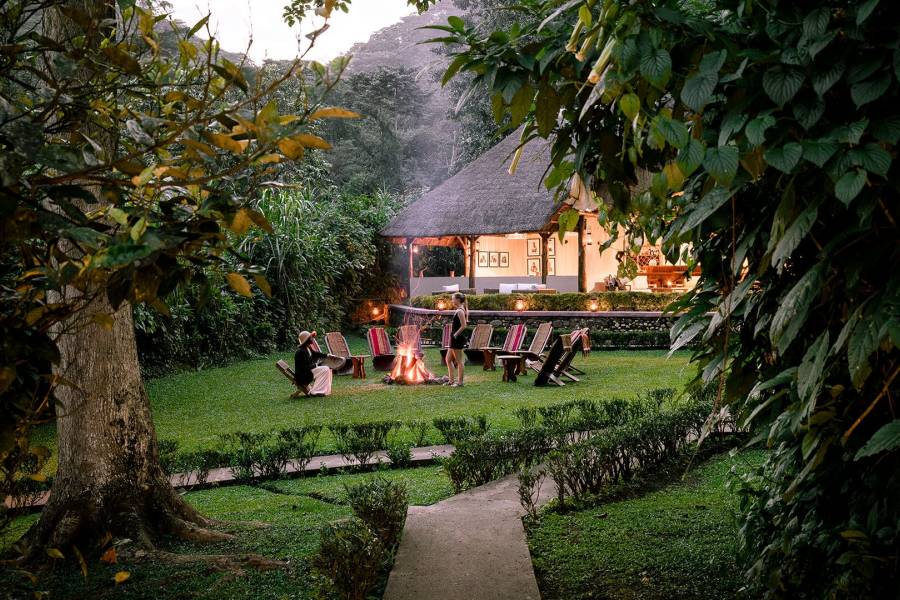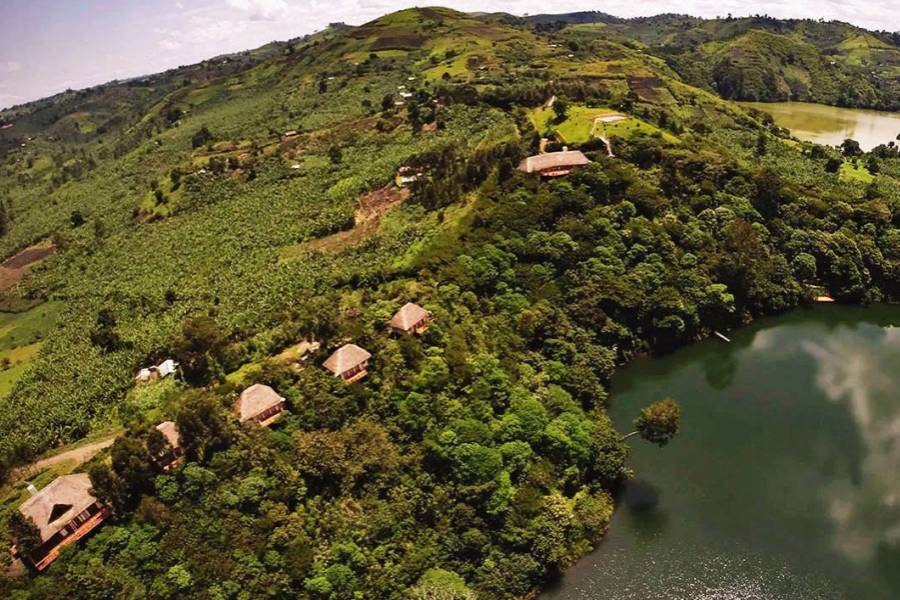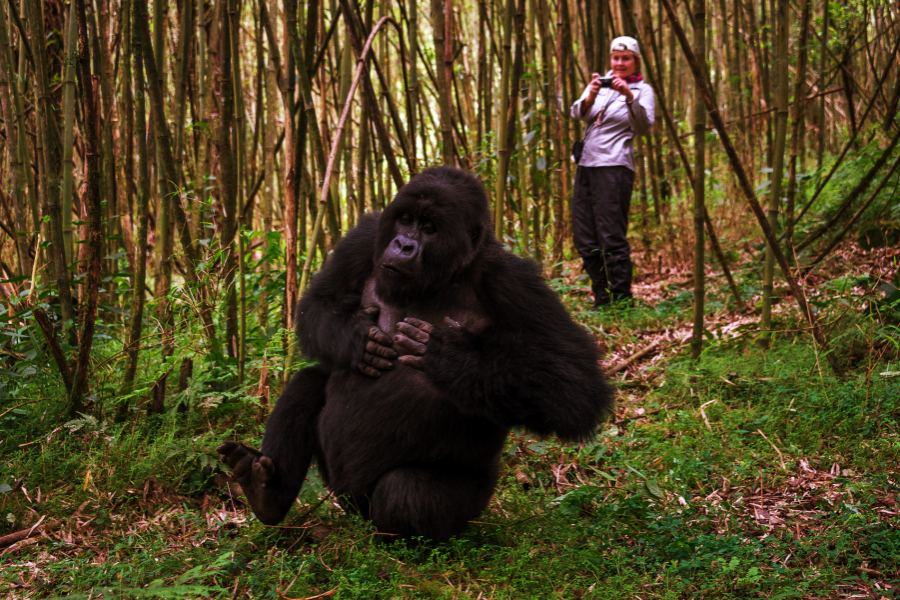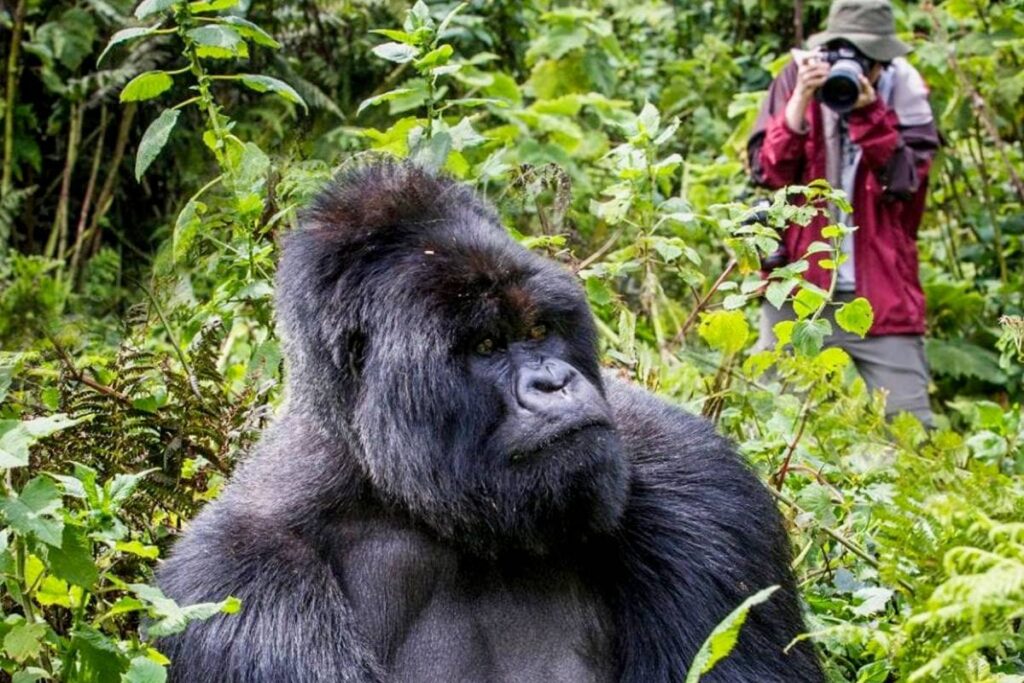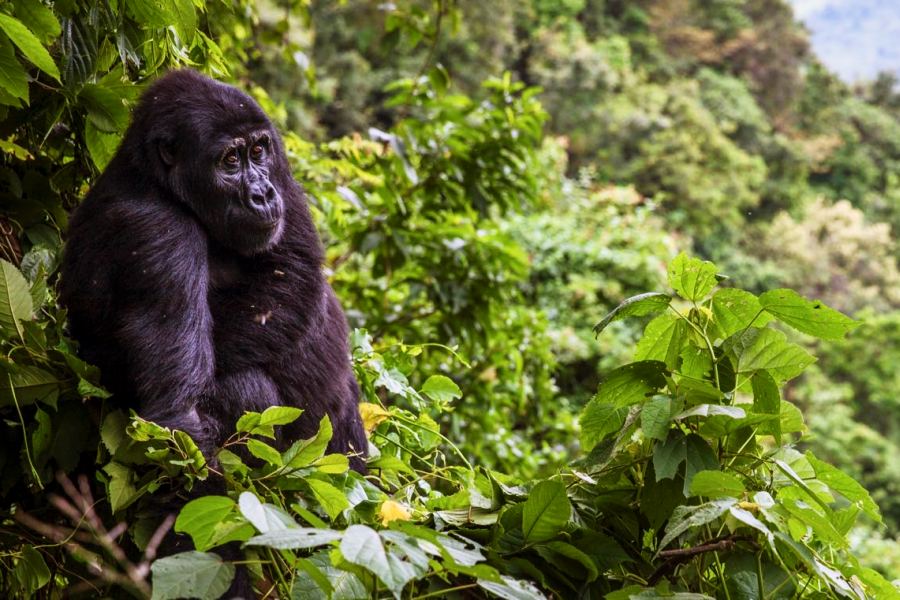Don’t be put off by its intimidating name: you’ll be led into Bwindi by naturalist guides and trackers and the reward is worth the effort – this majestic forest is where to go in Uganda for your gorilla trekking experience. Spend an hour with a gorilla family, observing these gentle giants in their pristine rainforest habitat before slipping away and back to your comfortable jungle lodge. A gorilla trek is wet, humid, muddy and tough but the experience is absolutely extraordinary.
Uganda Safari
If you’ve ever wanted to sit with mountain gorillas in their natural rainforest habitat then a Uganda safari will deliver on your expectations. Boasting a 90% success rate at finding habituated gorilla family groups in the extraordinary Bwindi Impenetrable Forest, gorilla trekking in Uganda has become one of Africa’s most powerful wildlife experiences and such is its success that the gorilla population is actually increasing.
But don’t think that a Uganda safari is only about gorillas in rainforests: this landlocked East African country is home to a range of diverse national parks and is a strong contender for one of the world’s best bird watching destinations. Head for Murchison Falls or Queen Elizabeth National Park for classic big game viewing, chimpanzee trekking and river cruises.
Kibale, in southern Uganda, forms a massive wildlife corridor with Queen Elizabeth National Park that is used by migrating elephants in search of water. A mixture of tropical rainforest, swamp and grasslands, Kibale supports Africa’s biggest population of chimpanzees as well as at least a dozen other primate species. It is a top destination for those wanting to trek primates, including gorillas, and with over 320 recorded bird species, is also a haven for twitchers.
A green, hilly and elevated country with many lakes and mountains, Uganda’s appeal lies in its simplicity. Infrastructure is limited but growing and there is now a good range of safari accommodation and city-based hotels. Ideal for seasoned safari-goers, bird watchers and wildlife enthusiasts, Uganda’s star is on the rise – combine it with Kenya or Tanzania for a holistic East African safari experience.
What travelers most enjoyed about Uganda
Where to Go in Kenya
For a small, landlocked country of which almost 25% is lakes and rivers, Uganda certainly packs in the places of interest. Mountainous, forested Bwindi National Park is where to go in Uganda for gorilla treks but the country is also home to large savannah reserves, lowland rainforests and enchanting lakes which – in combination – make for one of the biggest wildlife experiences in Africa.
Kampala: capital city & gateway to Uganda
A typical African capital with a compact, high-rise centre surrounded by sprawling suburbs, busy Kampala is Uganda’s commercial, political and logistical hub but also one of East Africa’s most laid-back and friendly cities.
Uganda’s only international airport is set next to Lake Victoria in Entebbe 35kms away. This small town serves as the country’s main entry and exit point and many visitors will spend a night here or in Kampala before and after their Uganda safari.
Bwindi Impenetrable Forest: gorilla trekking & rainforest wildlife
Murchison Falls National Park: game viewing, river cruises & birding
With the Nile River neatly bisecting Uganda’s largest park, you’d expect a wide range of animals at Murchison Falls and you’d be right. It’s where to go in Uganda for classic big game species such as elephant, buffalo, lion and hippo and with a bird count of nearly 500, Murchison Falls also boasts chimpanzees and colobus monkeys in its forests.
The piece de resistance however is a boat cruise to the spectacular falls themselves where the thundering Nile is squeezed through a 7-metre cleft in the Rift Valley Escarpment.
Queen Elizabeth National Park: birding, game viewing, chimps & river cruises
Combining easily with Bwindi Forest, Queen Elizabeth National Park is Uganda’s most popular and most accessible savannah reserve and is home to elephant, buffalo, leopard, numerous antelope species and the famous tree-climbing lions of the Ishasha Plains.
Take a boat cruise on the Kazinga Channel to spot hippo and crocodile and don’t forget your binoculars: with a staggering 600 recorded bird species, Queen Elizabeth NP is one of the world’s premier bird watching destinations.
Bwindi Impenetrable Forest: gorilla trekking & rainforest wildlife
Don’t be put off by its intimidating name: you’ll be led into Bwindi by naturalist guides and trackers and the reward is worth the effort – this majestic forest is where to go in Uganda for your gorilla trekking experience. Spend an hour with a gorilla family, observing these gentle giants in their pristine rainforest habitat before slipping away and back to your comfortable jungle lodge. A gorilla trek is wet, humid, muddy and tough but the experience is absolutely extraordinary.
Murchison Falls National Park: game viewing, river cruises & birding
With the Nile River neatly bisecting Uganda’s largest park, you’d expect a wide range of animals at Murchison Falls and you’d be right. It’s where to go in Uganda for classic big game species such as elephant, buffalo, lion and hippo and with a bird count of nearly 500, Murchison Falls also boasts chimpanzees and colobus monkeys in its forests.
The piece de resistance however is a boat cruise to the spectacular falls themselves where the thundering Nile is squeezed through a 7-metre cleft in the Rift Valley Escarpment.
Queen Elizabeth National Park: birding, game viewing, chimps & river cruises
Combining easily with Bwindi Forest, Queen Elizabeth National Park is Uganda’s most popular and most accessible savannah reserve and is home to elephant, buffalo, leopard, numerous antelope species and the famous tree-climbing lions of the Ishasha Plains.
Take a boat cruise on the Kazinga Channel to spot hippo and crocodile and don’t forget your binoculars: with a staggering 600 recorded bird species, Queen Elizabeth NP is one of the world’s premier bird watching destinations.
Kibale Forest National Park: primates, birds & butterflies
Rapidly becoming a must-do destination in Uganda, Kibale Forest offers visitors an accessible and enlightening insight into life in a tropical rainforest. Large mammals aren’t so easily seen but the clouds of dazzling butterflies and gorgeous forest birds more than make up for it, and besides, Kibale is most famous for its primates. Go on guided chimpanzee treks in the majestic forest and see how many of the other 12 primate species you can spot.
As one of Uganda’s wildlife gems, Kibale is a top priority for visitors wanting to trek gorillas and chimpanzees during the dry seasons, which are generally from November to February, and in June and September (the rainy seasons are March to May, and September to November). While searching for habituated chimps and gorillas, you could also discover other primates like red colobus, black-and-white colobus, potto, blue monkeys, olive baboons and rare L’Hoest’s monkeys.
There is plenty of other wildlife about, thanks to the contiguous wildlife corridor with Queen Elizabeth National Park. Elephants, bush pigs and antelope as well as predators like lions, serval, leopards and African golden cats are all found here. The 351 recorded tree species make for a diverse, lush and gorgeous backdrop.
Birders will revel in the 325 recorded bird species that include the yellow-rumped tinker, African grey parrot and the endemic ground thrush. The park’s community runs the famous Bigodi Swamp Walk, where an impressive 325 bird species have been counted.
Lake Mburo National Park: serene game viewing & birding
Halfway between Uganda’s capital and entry point Kampala and the gorilla trekking forests of the south-west lies Lake Mburo, a perfect overnight stop-over for travellers making their way between the two destinations.
Although the heavyweights such as elephant are missing, the great mix of wetland and woodland habitats makes for a wide range of mammals and birds and Mburo’s tranquil atmosphere and soothing views provide welcome relief after a tough journey.
Best Time to Go to Uganda
Uganda’s raised topography means a cooler climate than its equatorial setting suggests but if you’re planning a gorilla trek, it’s important to know when to go to Uganda for the easiest trekking conditions. Although it’s regarded as a year-round activity, the best time to visit Uganda for gorilla trekking is during the country’s two dry seasons: January and February and from June to September.
Game viewing in Uganda’s savannah parks is best at the end of the dry seasons – February and March and September/early October – when wildlife is concentrated around water sources. Bird watching is fantastic all year round but is at its peak between November and April when migrant species are present. We’d recommend avoiding a Uganda safari entirely during the heavy rains of April and May.
Uganda Travel Advice
There’s nothing like up-to-date, relevant travel information direct from the experts – get African Landmark Safaris’ essential Uganda travel advice before you go.
Money & Spending
Uganda’s unit of currency is the Uganda Shilling and you’d be advised to get some on arrival as it is far easier to buy drinks, curios and meals in the local currency when travelling between destinations.
US Dollars are widely accepted throughout the country though note that cash is best: traveller’s cheques and credit cards can be used at most lodges and in Kampala but attract hefty transaction fees.
Tipping
Tipping of around 10 – 15% is customary in Uganda for good service. Tips are usually given in Uganda Shillings or US Dollars. If you are doing a gorilla trek, tipping is at your discretion – your porter (if you choose to take one) should usually receive the highest tip, with a second tip distributed between your guides, trackers and security personnel.
For in-depth tipping guidelines, enquire with one of our Africa Safari Experts – they’d be happy to share their knowledge with you.
Climate
Average year-round temperatures: 14°C to 27°C
Rainy seasons: March to May and September to December
Refer to “best time to visit Uganda” for climate charts and advice on the best times of year for gorilla trekking.
What to Pack
During the day, temperatures in Uganda are generally warm so pack plenty of lightweight clothing. If you are going gorilla trekking, pack long trousers and long-sleeved tops, long socks to wear over your trousers as protection against ants, a pair of light gloves to protect against nettles, a hat and a raincoat.
A pair of sturdy, comfortable hiking boots is most important – try to break these in before your trip rather than wearing them brand new as you’re likely to get blisters.
The mountains tend to be cold and damp so pack according to the altitude – a change of clothes and a warm fleece in your day pack, along with sunscreen and insect repellent are advised.
Flights & Getting Around
Did you know you can book your flights through African Landmark Safaris? For more information and frequently asked questions, please see our Flights section.
Entebbe International Airport: located 35km from Kampala, Entebbe is Uganda’s international gateway. Visitors usually arrive via Nairobi.
Flying by private charter aircraft is very expensive in Uganda – most travellers use road transfers with mini buses or, preferably, 4X4 vehicles.
Despite Uganda’s small size, infrastructure is limited and roads are often in poor condition; expect long days in vehicles when driving between destinations, especially in the rainy season. Game drives in the national parks are generally conducted in open-sided 4X4s.
Visa & Passport Requirements
All visitors to Uganda require a visa and every visitor’s passport must be valid for at least six months from their departure date. Visas for Uganda can be obtained at all major borders as well as at the international airport at Entebbe. Single and double-entry visas are valid for up to three months at a cost of around US $30 and extensions are available at the immigration office in Kampala.
About Uganda
History & Economy
Settled for at least 50 000 years, Uganda’s indigenous people included the pygmoid Batwa, a hunter-gatherer society displaced by the arrival of Central African cattle herders and farmers. The development of political dynasties resulted in a sophisticated pre-colonial history and by the time Arab and European explorers, traders and slavers reached the region, the Buganda Kingdom was well established. Colonised by Britain, independence came in 1962 but it was only in the mid-1980s, after the catastrophic regimes of Milton Obote and Idi Amin, that Uganda experienced social stability and economic growth.
Fertile soils and regular rainfall mean an economy built around agriculture. Cash crops such as coffee, tea and tobacco dominate the export market but most agriculture in Uganda is subsistence farming, occupying some 75% of the workforce. Significant mineral, gas and oil deposits are set to be exploited in the future while tourism has proved to be an ever-growing sector of the economy.
People & Culture
Uganda’s 34 million people are concentrated in the country’s better watered south and west with the Kampala-based Baganda the largest of the country’s many ethnic groups. Some 40 regional languages exist but Swahili and English are Uganda’s official languages. Religious belief is overwhelmingly Christian-based though Islam is strong in Uganda’s Asian communities. It should be noted that Ugandans hold their ancestry in high regard.
Uganda is a conservative country and visitors would do well to adhere to local rules of behaviour. That said, visitors often remark on the friendliness and politeness of the locals: greetings are an elaborate affair and may include inquiries as to the health of your family – perfunctory greetings and a demand for immediate action are somewhat frowned upon!
Landscape & Wildlife
Lying in a basin between the eastern and western branches of the Rift Valley, Uganda’s elevated position means a more temperate climate than its equatorial location might suggest. Most of the country is over 1 000m in altitude and relatively flat apart from the forested mountain ranges that often define its borders. One of Africa’s most well-watered countries (25% of Uganda is covered by lakes, rivers and wetlands) the landscape is lush and green for most of the year though northern Uganda grades into semi-desert.
Such a setting makes for staggering biodiversity. Uganda’s montane and lowland forests are home to mountain gorillas, chimpanzees and other forest animals while its savannah parks – Queen Elizabethand Murchison Falls – offer classic game viewing, though not on the scale of Kenya or Tanzania.
Uganda wildlife highlights include gorilla trekking in Bwindi Forest, chimpanzee encounters in Kibale Forest and bird watching – with over 1 000 recorded species, Uganda is one of the world’s top birding destinations.
Best Uganda Tours & Safaris
Big on drama but somewhat short on infrastructure, Uganda offers a multitude of adventures that are best experienced on an organised tour or safari. Choose from short, intensive gorilla trekking hikes into Bwindi Impenetrable Forest; gorilla and chimp combination adventures that include Bwindi and Kibale National Park; and longer safari tours that focus on savannah wildlife, primates big and small and adventure activities such as white-water rafting on the Nile and mountain trekking.
Tours and safaris in Uganda are not for the faint-hearted however: the roads aren’t great, it rains often and driving between destinations can be long and tiring. Uganda’s famous gorilla trekking may be on everyone’s to-do list but it’s a physically demanding experience in tough conditions. However, the experience of meeting a mountain gorilla face to face is truly a moment to be remembered for a lifetime.
Our selection of Uganda tours and safaris include both affordable and luxury options but if you can’t find what you’re looking for, one of our East Africa Safari Experts will happily tailor-make a trip to suit your needs and budget.
Best Uganda Accommodation
Most famous for the mountain gorillas of Bwindi Impenetrable Forest as well as safari destinations like Kibale, Murchison Falls and Queen Elizabeth National Parks, Uganda’s accommodation is concentrated around the wildlife hotspots in the south and west of the country. Generally smaller, more intimate and not as luxuriously opulent as their Kenyan or Tanzanian equivalents, lodges and camps in Uganda nevertheless deliver friendly service, plenty of comfort and good food.
Our selection of Uganda accommodation ranges from affordable tented camps to luxury lodges – if you need help, just contact one of our African Safari Experts for advice on choosing the right accommodation for your requirements.


